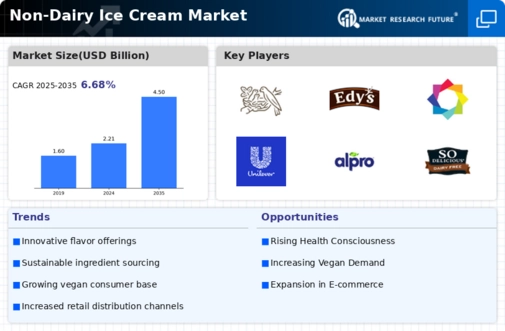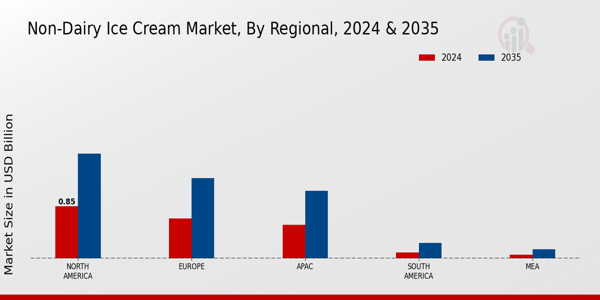Market Growth Projections
Expansion of Distribution Channels
The expansion of distribution channels plays a crucial role in the Global Non-Dairy Ice Cream Market Industry. As retailers increasingly recognize the demand for non-dairy options, they are incorporating these products into their offerings, both in physical stores and online platforms. This accessibility is vital for reaching a broader audience, particularly as e-commerce continues to grow. The convenience of online shopping allows consumers to explore a wider variety of non-dairy ice cream products, contributing to market growth. As distribution networks evolve, the industry is likely to see enhanced visibility and availability, further driving consumer adoption.
Sustainability and Ethical Sourcing
Sustainability and ethical sourcing practices are increasingly shaping the Global Non-Dairy Ice Cream Market Industry. Consumers are becoming more discerning about the environmental impact of their food choices, leading to a preference for products made from sustainably sourced ingredients. Brands that prioritize eco-friendly practices and transparent supply chains are likely to resonate with environmentally conscious consumers. This trend not only enhances brand loyalty but also positions companies favorably in a market projected to grow significantly. As sustainability becomes a core value for many consumers, the industry may see a shift towards more responsible production methods and packaging solutions.
Health Consciousness Among Consumers
Health consciousness among consumers is a pivotal driver for the Global Non-Dairy Ice Cream Market Industry. With rising concerns over obesity and related health issues, individuals are increasingly opting for lower-calorie, dairy-free desserts. This trend is reflected in the market's anticipated growth, with projections indicating a value of 4.5 USD Billion by 2035. Non-dairy ice cream products often contain fewer calories and saturated fats compared to traditional ice cream, making them an attractive choice for health-oriented consumers. As brands emphasize nutritional benefits, the market is likely to expand further, catering to the evolving preferences of health-conscious individuals.
Innovative Flavor Profiles and Ingredients
Innovation in flavor profiles and ingredients significantly influences the Global Non-Dairy Ice Cream Market Industry. Manufacturers are experimenting with unique combinations, such as exotic fruits, spices, and superfoods, to attract adventurous consumers. This creative approach not only enhances the sensory experience but also aligns with the growing trend of premiumization in the food sector. As a result, the market is poised for growth, with a projected CAGR of 6.68% from 2025 to 2035. By offering distinctive flavors and high-quality ingredients, brands can differentiate themselves in a competitive landscape, appealing to consumers seeking novel dessert experiences.
Rising Demand for Plant-Based Alternatives
The Global Non-Dairy Ice Cream Market Industry experiences a notable surge in demand for plant-based alternatives, driven by increasing consumer awareness regarding health and sustainability. As more individuals adopt vegan or lactose-free diets, the market is projected to reach 2.21 USD Billion in 2024. This shift is indicative of a broader trend towards plant-based consumption, with consumers seeking healthier dessert options that align with their dietary preferences. The industry is likely to benefit from this growing inclination, as brands innovate to create appealing flavors and textures that cater to diverse palates.













